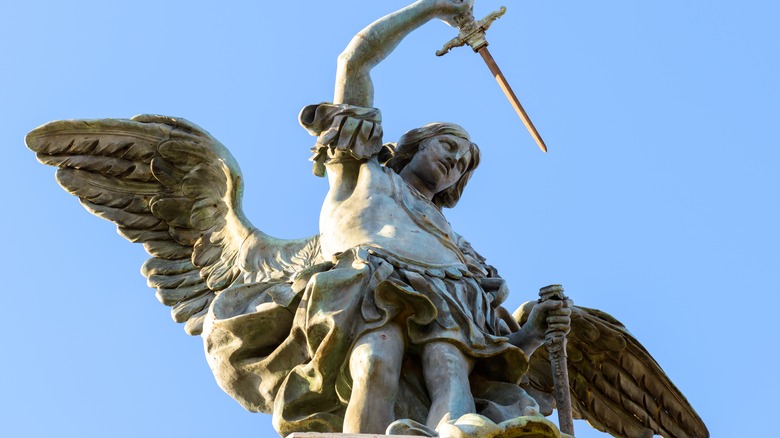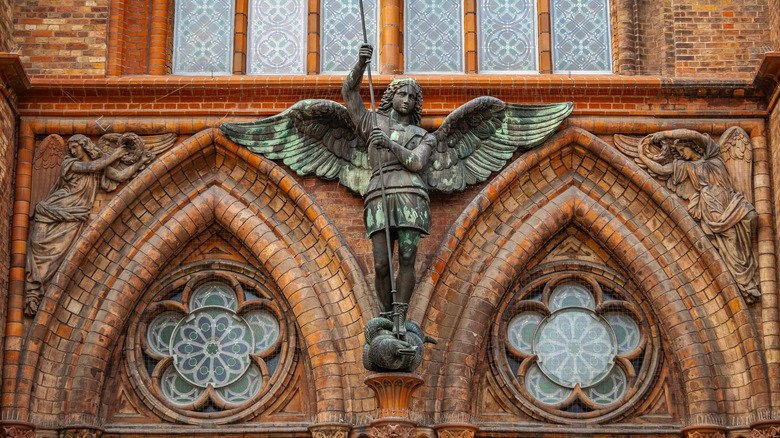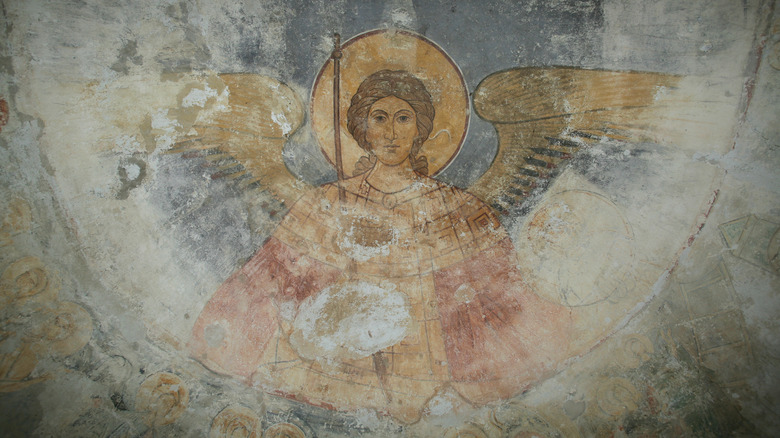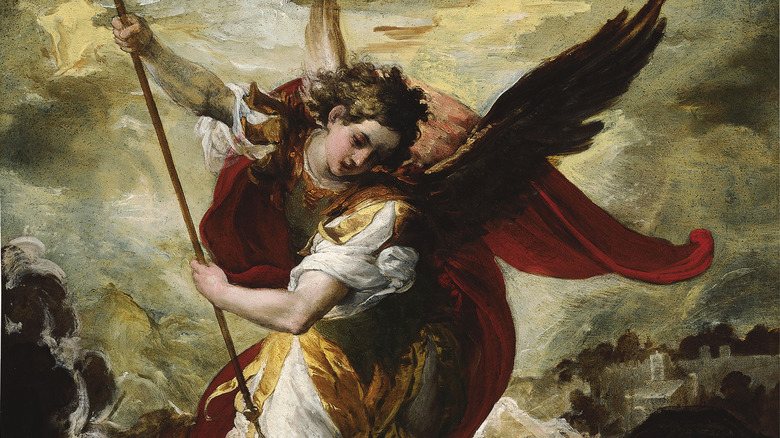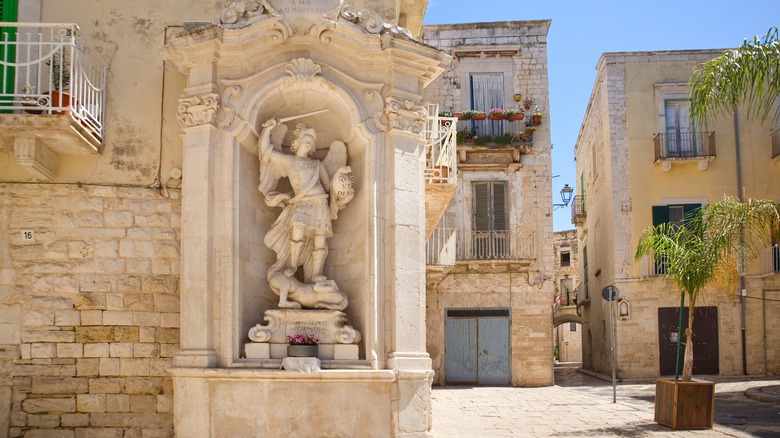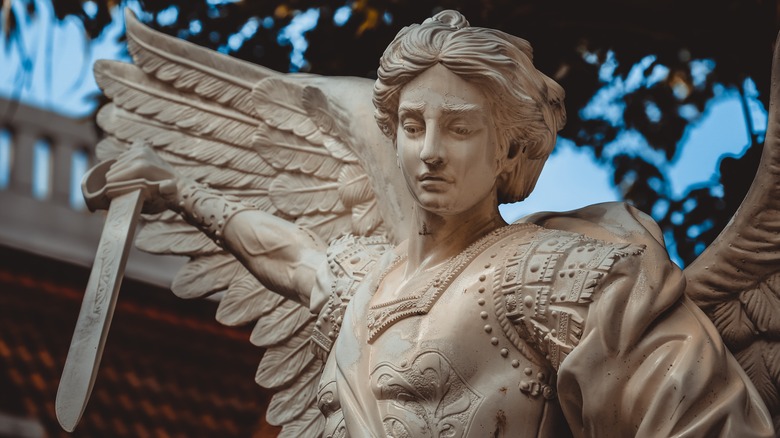Things People Get Wrong About Michael The Archangel
When it comes to biblical lore, many people get the basic facts right, at least regarding Jesus' big life events: The manger and the three wise men, the crucifixion, the resurrection, etc. Other folks might recognize names from the Old Testament but not know much about them: King David, Jonah (the whale guy), Noah (the ark guy), Elijah the prophet, etc. But when we look into less-discussed biblical characters, facts often get mixed up with untruths, pop cultural misconceptions, or come across as confusing. Biblical angels, archangels, and the whole heavenly hierarchy definitely fall into that last category, including Michael, the archangel.
Unraveling the truth about Michael requires diving into a decently deep rabbit hole. Some folks say that there are seven archangels, and widely-used sites like Learn Religion even name them: Michael, Gabriel, Raphael, Uriel, Raguel, Zerachiel (sometimes spelled Saraqael), and Remiel. But, the latter four characters belong to non-canonical texts like the Book of Enoch, not the official Christian Bible. Enoch, after whom the book is named, is the great-grandfather of Noah mentioned in Genesis 5. So, there's some crossover between canon and non-canon.
The Book of Enoch mostly calls these seven angels "Watchers." In the canonical Christian Bible, only Michael is called an "archangel," and then only in the New Testament letter of Jude. In the Old Testament's Book of Daniel, Chapter 10, he's called "one of the chief princes," whatever that means. Overall, it takes some work to sort out what the Bible actually says about Michael.
Wrong Fact #1: Michael was one archangel of many
We already touched on the first false Michael fact that folks generally believe: Michael was one archangel of many. Granted, whether or not this statement is true boils down to whether folks reference the canonical Christian Bible — either the Catholic or Protestant version — or non-canonical books like the aforementioned Book of Enoch. This difference impacts every other aspect of the Michael character, and is likely part of the reason why there's confusion about him. This contrast also gets compounded because of discrepancies between the Old and New Testaments.
The official Christian Bible dates back to the late 4th century C.E., over 350 years after the accepted death of Jesus. At that time, St. Jerome finalized the New Testament and combined it with the existing Old Testament to make one whole book of books. The Old Testament consisted of 39 books, and the New Testament 27 books to make 66 total. Michael only shows up five times across the entire thing: Three times in the Old Testament (Daniel 10:13, Daniel 10:21, and Daniel 12:1) and two times in the New Testament (Jude 1:9 and Revelation 12:7).
Even though other angels like Gabriel pop up in the Christian Bible (as well as the Hebrew Bible and the Quran), only Michael gets the title "archangel" in the New Testament in Jude. The Greek word used is "archaggelos," or "chief angel." And yet, Old Testament passages like Daniel 10 refer to him as "one of the chief princes," implying that there's more than one Michael-type entity.
Wrong Fact #2: Michael plays a big bibilical role
Even though the archangel Michael is a recognizable name, he's not as big of a figure in the canonical Christian Bible. We already mentioned that he only appears five times across the whole work — three times in the Old Testament and two times in the New Testament (Jude 1:9 and Revelation 12:7). While a character who only appears a few times is not necessarily minor, it's also not the case that he's described as doing or saying a lot of impactful things until we get to the Bible's conclusion in Revelation.
In Daniel 10, an unnamed angel delivers a message to Daniel when he is in prison and mentions Michael, and that's it. Daniel 12 talks about apocalyptic times possibly referenced in the New Testament's Revelation and calls Michael "the great prince who protects your people," like some kind of political or military leader. But what does he do? No clue. Only in Revelation 12 does Michael play an active role when he and "his angels" fight "the dragon" (a story in and of itself) and wins.
Then there are Michael's words, which amount to four English-translated words in Jude 1: "The Lord rebuke you!" Michael makes this statement in a very odd conversation between him and the devil about the physical body of Moses. But what effect did these words have? Nothing is mentioned.
Wrong Fact #3: Michael has no specific function
Even though we just got through saying that Michael doesn't do or say much in the Christian Bible, that doesn't mean that he has no specific function to play in the work's cosmic story of humanity. That is, beyond being a heavenly avatar. And since we've already mentioned the only five biblical passages that discuss Michael, we know exactly where to look to determine his role in events.
Take Daniel 12, where Michael is described as "the great prince who stands guard over the sons of your [God's] people." This passage chronicles "a time of distress such as has not happened from the beginning of nations until then." Biblical scholars often take this as the apocalypse of Revelation, itself understood as a literal war in the Holy Land in the Middle East. This period of time leads directly to the final judgment of humanity and the separation of the redeemed from the damned via names written in "the book" (per Daniel 12) or "the book of life" (per Revelation 20). The "sons of your [God's] people" are Jewish people — the people of the Old Testament covenant with God.
And so, Michael has some predetermined function as the one who "stands guard" over the Almighty's chosen people in the time leading up to the apocalypse. According to the unnamed angel who appears to the imprisoned Daniel in Daniel 10, Michael came to "help" him while detained in Persia. The angel also says Michael "supports" him in his fight against the prince of the empire.
Wrong Fact #4: Michael never acts independently
Now we cross into theological territory that sometimes stirs debate: Do angels have free will? Bear in mind that like everything else in this article, we're speaking from a textual, literary perspective rather than from a place of any religious conviction.
Looking at the Christian Bible, we know that at least one angel has been directly credited with acting independently enough to rebel against God himself. Isaiah 14 calls him the "morning star," and Jesus references his fall from heaven in Luke 10 when he calls him "Satan," a common noun meaning "adversary" in Hebrew. The Greek word for "satan" is "diabolos," i.e., "devil" in English. So, the morning star, Satan, and the devil appear to be the same character. Plus, Revelation 12 says that the apocalyptic figure — "the dragon" — "swept a third of the stars out of the sky," which biblical scholars take to mean the one-third of God's angels that joined Satan's heavenly rebellion. We say this all this to mean: There's precedent for independent angelic decision-making.
So when Jude describes Michael having a little conversation with the devil (diabolos in Greek, remember), it comes across as an independent action. He's described as employing rationale and deciding not to "condemn him [the devil] for slander" but rather cite God as doing the condemning. Not only does Michael choose something for himself independently, he invokes the creator, which means that he has the capacity to do so as a distinct entity with his own will.
Wrong Fact #5: Michael is non-violent
Finally, we come to a point about the archangel Michael that embodies an unanswerable debate that still plays a vital, life-or-death role in modern life: The necessity of violence to bring about peace. Many Christians and non-Christians might envision Christians, Jesus, God, God's angels, etc., as a big lovey-dovey family of hippie harmony. That perspective leaves out not only much of the Bible's Old Testament but even crucial parts of the New, Jesus-centric Testament, including a critical chunk of the Michael story.
This chunk of the tale — which we mentioned earlier — defies the flowing, winged, dreamy-voiced vision some might have of angels. Namely, Michael is portrayed in Revelation 12 as a warrior or military leader. This is why so many sculptures and paintings of him over the centuries depict him in armor and wielding a weapon. Specifically, the passage in question refers to Michael and "his angels" (note the possessive), implying that the other angels in question follow him like a commander.
Michael, on the side of God and righteousness, fights off the dragon — aka the devil or Satan — in a cosmic combat showdown where Satan and his followers "lost their place in heaven." Revelation's apocalyptic timeline can be a bit hard to understand, but biblical scholars interpret this event as happening in the future. This means that Michael isn't just a cloud-dwelling angel — he's some sort of fighter whose violence helps bring about final peace.
